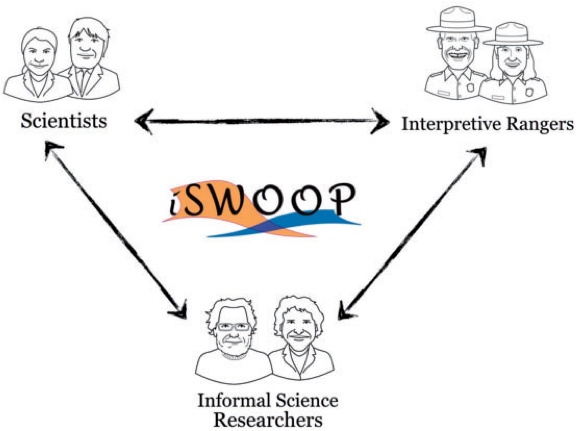A symposium generates rich thought on bringing science to the public through partnerships
This blog was co-authored with Tracey Wright, Senior Researcher & Developer at TERC. Merson is a Project Director at TERC and coordinates the National Science Foundation-funded project iSWOOP, or Interpreters and Scientists Working on Our Parks, with co-Principal Investigators Louise Allen and Nickolay Hristov. iSWOOP is designed to make active science research a visible, interactive part of ranger-led, interpretive programs for national park visitors. TERC is an independent, research-based organization that advances STEM learning and teaching for all through research, curriculum, and professional development.
Is the journal Integrative and Comparative Biology, formerly American Zoologist,on your Kindle or in your stack of reading materials? Probably not. However, in the July issue you might be surprised to find inspiring and helpful articles on topics you care about—professional development, exhibit design, broader impacts—from people active in the field of informal STEM learning. How did a journal for biologists become the vehicle for articles on these topics? Read on to find out.
The Genesis of a Symposium
At national and state parks, researchers and visitors are transient, while interpreters are a continuous presence. Opportunities for scientists and interpreters to be together are welcome, but are also relatively rare. One-time presentations are the typical format.
iSWOOP works to increase the public’s awareness of scientific research, increase rangers’ familiarity with the research, and offer scientists new audiences and allies for communicating science to those audiences. In our model, all parties contribute expertise,and all benefit from the exchange.

To extend that approach with a new spin, iSWOOP sponsored a symposium, “Science in the Public Eye: Leveraging Partnerships” as part of the 2018 annual
meeting for members of the Society for Integrative and Comparative Biology (SICB), a professional organization of biologists that fosters research in, as well as public awareness of, living organisms—from their cellular structures to their ecology and evolution.
The goal of the symposium was to make explicit the ways that infrastructure, expertise, and the amazing staff of informal science learning institutions work with scientists to advance shared goals. And instead of locating professional development at interpreters’ workplaces, iSWOOP invited interpreters from a range of national park units and other informal science learning centers to travel to this gathering of scientists.
Watch the Talks, Read the Articles, and Share with Potential Scientist Partners
We are pleased to share video recordings of the symposium presentations, and their corresponding articles, which were published in the July 2018 issue of Integrative and Comparative Biology. The authors and presenters represent an exciting mix of thoughtful leaders in the fields of informal STEM learning, science communication, and scientific research. The iSWOOP team is incredibly grateful to them for their contributions and to Oxford University Press for providing (time-limited) access to the informal STEM education community via InformalScience.org, particularly those in the National Science Foundation’s Advancing Informal STEM Learning portfolio.
The articles will likely confirm what you know to be true—informal STEM educators have much to offer scientists who are interested in outreach, visibility for their work, and broader impacts. We encourage you to read and share articles when you forge new partnerships with scientists. We hope that the ideas help future collaborations flourish and nourish all participants and partners.
| Title | Author(s) | ICB Article | Symposium Talk |
|---|---|---|---|
| Science in the Public Eye: Leveraging Partnerships—An Introduction | Martha Merson, Louise Allen, and Nickolay Hristov | Paper | Video |
| Unveiling Impact Identities: A Path for Connecting Science and Society | Julie Risien and Martin Storksdieck | Paper | Video |
| Science in Places of Grandeur: Communication and Engagement in National Parks | Tim Watkins, Abraham Miller-Rushing, and Sarah Nelson | Paper | Video |
| Beyond the Brown Bag: Designing Effective Professional Development for Informal Educators | Louise Allen, Cynthia Char, Nickolay Hristov, Tracey Wright, and Martha Merson | Paper | Video |
| So You Want to Share Your Science… Connecting to the World of Informal Science Learning | Carol Lynn Alpert | Paper | No video |
| Developing Interactive Exhibits with Scientists: Three Example Collaborations from the Life Sciences Collection at the Exploratorium | Denise King, Joyce Ma, Angela Armendariz, and Kristina Yu | Paper | Video |
| Species Loss: Exploring Opportunities with Art-Science | Jennifer “Juniper” Harrower, Jennifer Parker, and Martha Merson | Video | |
| Designing for Broad Understanding of Science Insights from Practice | Nickolay Hristov, Carol Strohecker, Louise Allen, and Martha Merson | Paper | Video |
| Cultivating Collaborations: Site Specific Design for Embodied Science Learning | Katherine Gill, Jocelyn Glazier, and Betsy Towns | Video | |
| On the Cutting Edge of Research to Conserve At-Risk Species: Maximizing Impact through Partnerships | Shauna Marquardt, Mandy Annis, Ryan Drum, Stephanie Longstaff Hummel, David Mosby, and Tamara Smith | Video | |
| Exposing the Science in Citizen Science: Fitness to Purpose and Intentional Design |
Julia Parrish, Hillary Burgess, Jake Welztin, Lucy Fortson, Andrea Wiggins, and Brooke Simmons |
Paper | Video |
Financial Support
The symposium and its proceedings were made possible with support from the Society for Integrative and Comparative Biology, in particular, the Divisions of Animal Behavior, Comparative Biomechanics, Comparative Endocrinology, Ecoimmunology and Disease Ecology, Neurobiology, and Vertebrate Morphology. Previous support was provided by the National Science Foundation (DRL-1323030 and DRL-1514776). Any opinions, findings, and conclusions or recommendations expressed in this material are those of the authors and do not necessarily reflect the view of the National Science Foundation.